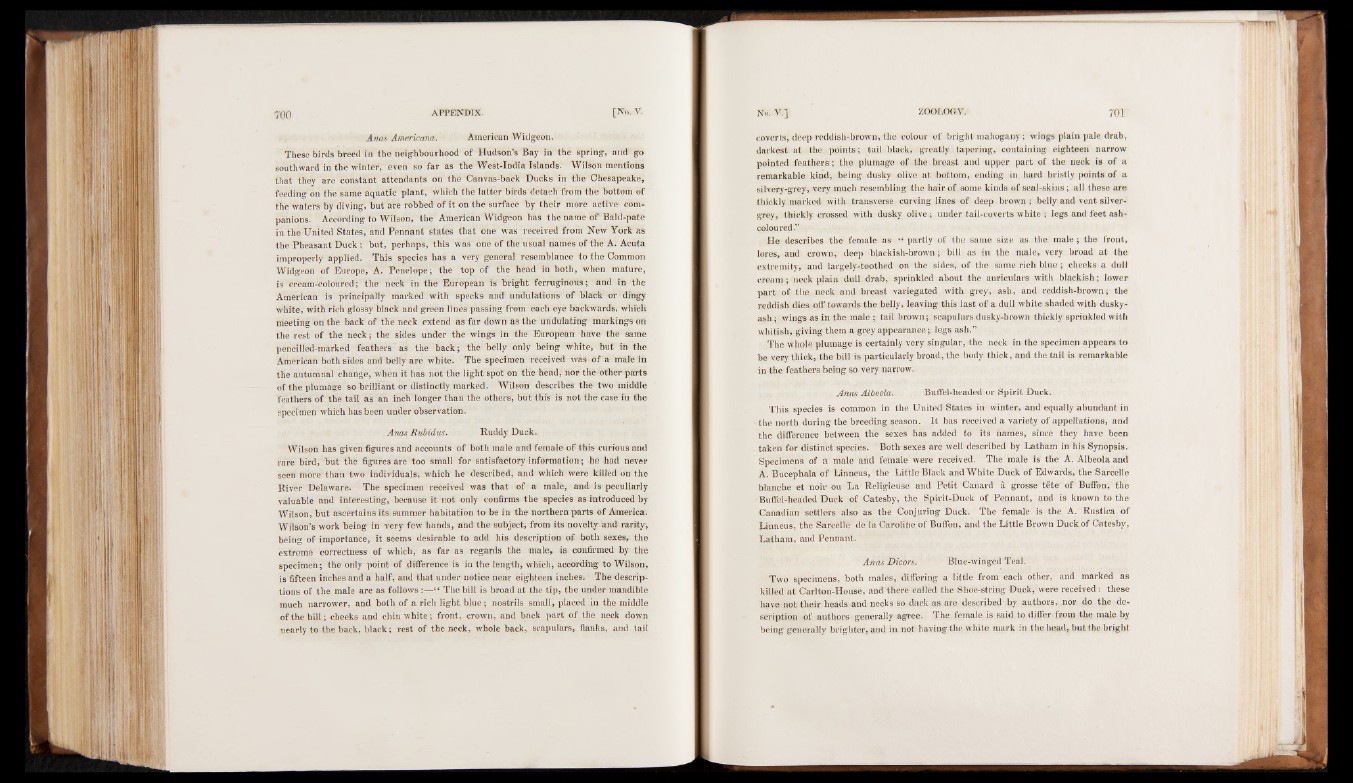
Anas Americana. American Widgeon.
These birds breed in the neighbourhood of Hudson’s Bay in the spring, and go
southward in the winter, even so far as the West-India Islands. Wilson mentions
that they are constant attendants on the Canvas-back Ducks in the Chesapeake,
feeding on the same aquatic plant, which the latter birds detach from the bottom of
the waters by diving, but are robbed of it on the surface by their more active companions.
According to Wilson, the American Widgeon has the name of Bald-pate
in the United States, and Pennant states that one was received from New York as
the Pheasant Duck ; but, perhaps, this was one of the usual names of the A. Acuta
improperly applied. This species has a very general resemblance to the Common
Widgeon of Europe, A. Penelope; the top of the head in both, when mature,
is cream-coloured; the neck in the European is bright ferruginous; and in the
American is principally marked with specks and undulations of black or dihgy
white, with rich glossy black and green lines passing from each eye backwards, which
meeting on the back of the neck extend as far down as the undulating markings on
the rest of the neck; the sides under the wings in the European have the same
pencilled-marked feathers as the back; the belly only being white, but in the
American both sides and belly are white. The specimen received was of a male in
the autumnal change, when it has not the light spot on the head, nor the other parts
of the plumage so brilliant or distinctly marked. Wilson describes the two middle
fèathers of the tail as an inch longer than the others, but this is not the case in the
specimen which has been under observation.
Anas Rubidus. Ruddy Dusk.
Wilson has given figures and accounts of both male and female of this curious and
rare bird, but the figures are too small for satisfactory information; he had never
seen more than two individuals, which he described, and which were killed on the
River Delaware. The specimen received was that of a male, and is peculiarly
valuable and interesting, because it not only confirms the species as introduced by
Wilson, but ascertains its summer habitation to be in the northern parts of America.
Wilson’s work being in very few hands, and the subject, from its novelty and rarity,
being of importance, it seems desirable to add his description of both sexes, the
extreme correctness of which, as far as regards the male, is confirmed by the
specimen; the only point of difference is in the length, which, according to Wilson,
is fifteen inches and a half, and that under notice near eighteen inches. The descriptions
of the male are as follows :—“ The bill is broad at the tip, the under mandible
much narrower, and both of a rich light blue; nostrils small, placed in the middle
of the bill; cheeks and chin white; front, crown, and back part of the neck down
nearly to the back, black; rest of the neck, whole back, scapulars, flanks, and tail
coverts, deep reddish-brown, the colour of bright mahogany ; wings plain pale drab,
darkest at the points; tail black, greatly tapering, containing eighteen narrow
pointed feathers ; the plumage of the breast and upper part of the neck is of a
remarkable kind, being dusky olive at bottom, ending in hard bristly points of a
silvery-grey, very much resembling the hair of some kinds of seal-skins ; all these are
thickly marked with transverse curving lines of deep brown ; belly and vent silver-
grey, thickly crossed with dusky olive; under tail-coverts white ; legs and feet ash-
coloured .v ;;
He describes the female as “ partly of the same size as the male ; the front,
lores, and crown, deep blackish-brown; bill as in the male, very broad at the
extremity, and largely-toothed on the sides, of the same rich blue ; cheeks a dull
cream; neck plain dull drab, sprinkled about the auriculars with blackish; lower
part of the neck and breast variegated with grey, ash, and reddish-brown; the
reddish dies off towards the belly, leaving this last of a dull white shaded with dusky-
asli ; wings as in the male ; tail brown ; scapulars dusky-brown thickly sprinkled with
whitish, giving them a grey appearance; legs ash.”
The whole plumage is certainly very singular, the neck in the specimen appears to
be very thick, the bill is particularly broad, the body thick, and the tail is remarkable
in the feathers being so very narrow.
Anas Albeola. Buffel-headed or Spirit Duck.
This species is common in the United States in winter, and equally abundant in
the north during the breeding season. It has received a variety of appellations, and
the difference between the sexes has added to its names, sincè they have been
taken for distinct species. Both sexes are well described by Latham in his Synopsis.
Specimens of a male and female were received. The male is the A. Albeola and
A. Bucephala of Linneus, the Little Black and White Duck of Edwards, the Sarcelle
blanche et noir ou La Religieuse and Petit Canard à grosse tête of Buffon, the
Buffel-headed Duck of Catesby, the Spirit-Duck of Pennant, and is known to the
Canadian settlers also as the Conjuring Duck. The female is the A. Rustica of
Linneus, the Sarcelle de la CaroHiie of Buffon, and the Little Brown Duck of Catesby,
Latham, and Pennant.
Anas JDicorsi Blue-winged Teal.
Two specimens, both males, differing a little from each other, and marked as
killed at Carlton-House, and there called the Shoe-string Duck, were received: these
have not their heads and necks so dark as are described by authors, nor do the ‘description
of authors generally agree. The female is said to differ from the male by
being generally brighter, and in not having the white mark in the head, but the bright